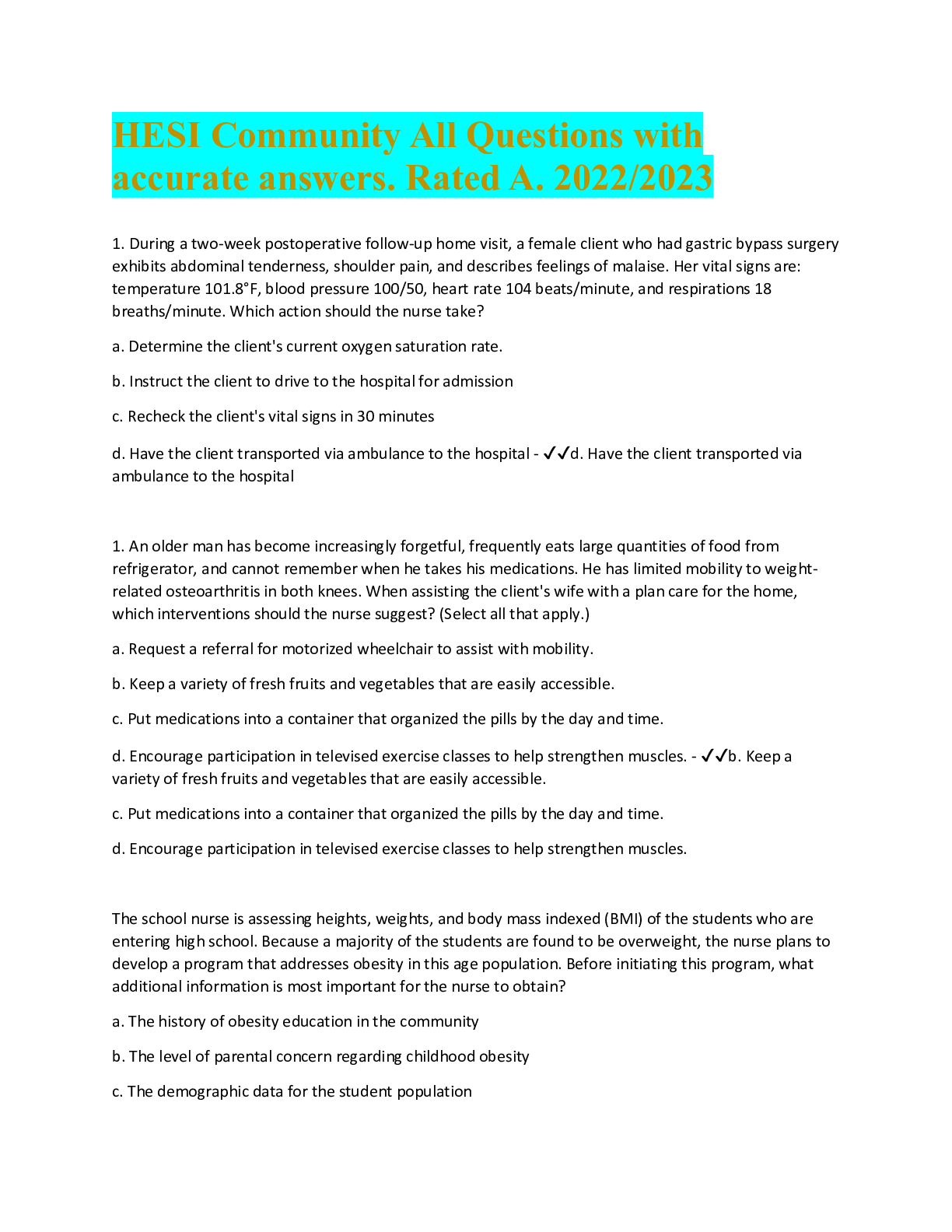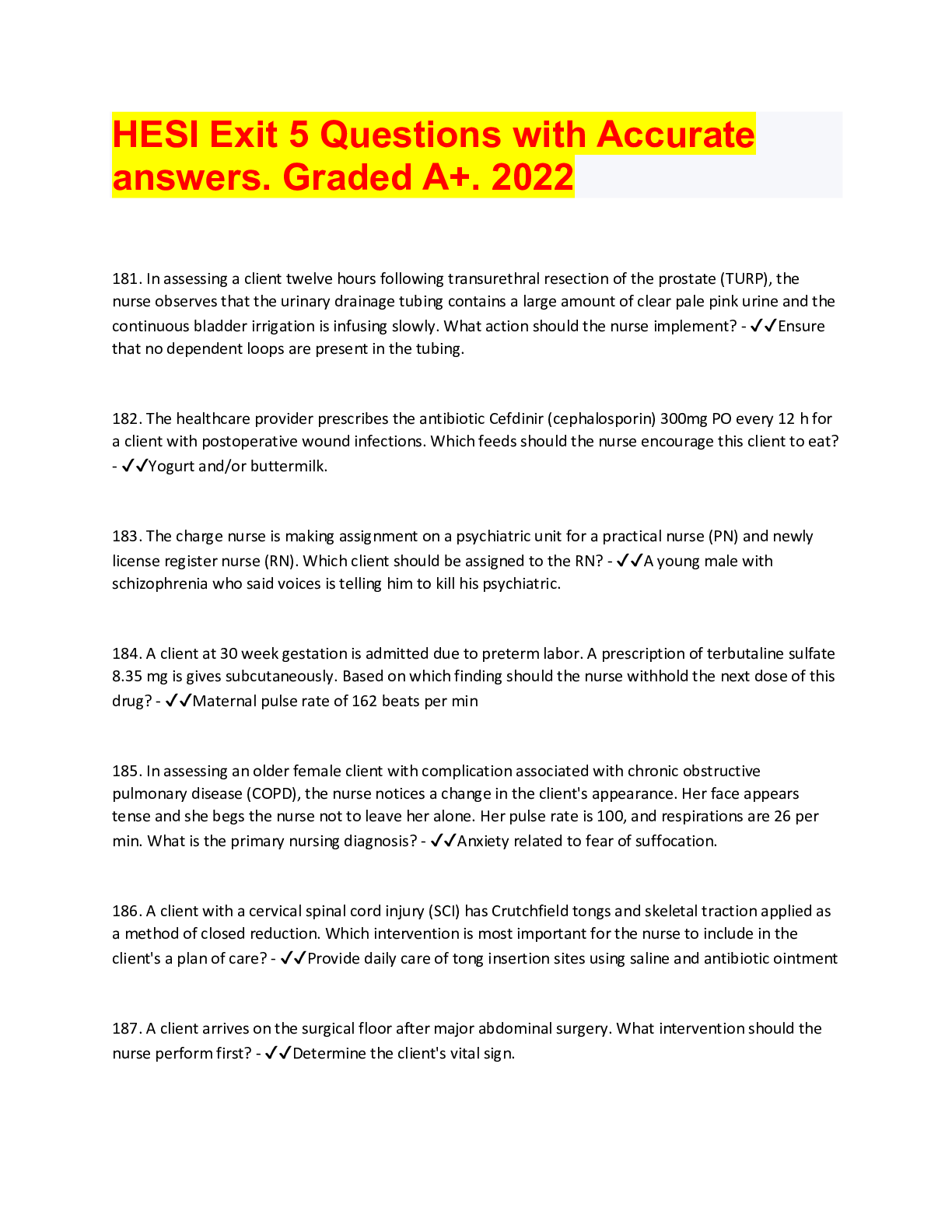*NURSING > HESI > Med-Surg II HESI Exam - set one Questions with accurate answers. 2022/2023. Latest updates (All)
Med-Surg II HESI Exam - set one Questions with accurate answers. 2022/2023. Latest updates
Document Content and Description Below
Med-Surg II HESI Exam - set one Questions with accurate answers. 2022/2023. Latest updates The nurse is completing a health assessment of a 42-year-old female with suspected Graves' Disease. The ... nurse should assess this client for: 1. anorexia 2. tachycardia 3. weight gain 4. cold skin - ✔✔2. tachycardia Graves' disease, the most common type of thyrotoxicosis, is a state of hypermetabolism. The increased metabolic rate generates heat and produces tachycardia and fine muscle tremors. Anorexia is associated with hypothyroidism. Loss of weight, despite a good appetite and adequate caloric intake, is a common feature of hyperthyroidism. Cold skin is associated with hypothyroidism. CN: Physiological adaptation; CL: Analyze When conducting a health history with a female client with thyrotoxicosis, the nurse should ask about which of the following changes in the menstrual cycle? 1. dysmenorrhea 2. metrorrhagia 3. oligomenorrhea 4. menorrhagia - ✔✔3. oligomenorrhea A change in the menstrual interval, diminished menstrual flow (oligomenorrhea), or even the absence of menstruation (amenorrhea) may result from the hormonal imbalances of thyrotoxicosis. Oligomenorrhea in women and decreased libido and impotence in men are common features of thyrotoxicosis. Dysmenorrhea is painful menstruation. Metrorrhagia, blood loss between menstrual periods, is a symptom of hypothyroidism. Menorrhagia, excessive bleeding during menstrual periods, is a symptom of hypothyroidism. CN: Physiological adaptation; CL: Analyze A 34-year-old female is diagnosed with hypothyroidism. The nurse should assess the client for which of the following? (Select all that apply.) 1. rapid pulse 2. decreased energy and fatigue 3. weight gain of 10 lbs (4.5 kg) 4. fine, thin hair with hair loss 5. constipation 6. menorrhagia. - ✔✔2. decreased energy and fatigue, 3. weight gain of 10 lbs (4.5 kg), 5. constipation, 6. menorrhagia Clients with hypothyroidism exhibit symptoms indicating a lack of thyroid hormone. Bradycardia, decreased energy and lethargy, memory problems, weight gain, coarse hair, constipation, and menorrhagia are common signs and symptoms of hypothyroidism. CN: Physiological adaptation; CL: Analyze Propylthiouracil (PTU) is prescribed for a client with Graves' disease. The nurse should teach the client to immediately report which of the following? 1. sore throat 2. painful, excessive menstruation 3. constipation 4. increased urine output - ✔✔1. sore throat The most serious adverse effects of PTU are leukopenia and agranulocytosis, which usually occur within the first 3 months of treatment. The client should be taught to promptly report to the health care provider signs and symptoms of infection, such as a sore throat and fever. Clients having a sore throat and fever should have an immediate white blood cell count and differential performed, and the drug must be withheld until the results are obtained. Painful menstruation, constipation, and increased urine output are not associated with PTU therapy. CN: Pharmacological and parenteral therapies; CL: Synthesize A client with thyrotoxicosis says to the nurse, "I am so irritable. I am having problems at work because I lose my temper very easily." Which of the following responses by the nurse would give the client the most accurate explanation of her behavior? 1. "Your behavior is caused by temporary confusion brought on by your illness." 2. "Your behavior is caused by the excess thyroid hormone in your system." 3. "Your behavior is caused by your worrying about the seriousness of your illness." 4. "Your behavior is caused by the stress of trying to manage a career and cope with illness." - ✔✔2. "Your behavior is caused by the excess thyroid hormone in your system." A typical sign of thyrotoxicosis is irritability caused by the high levels of circulating thyroid hormones in the body. This symptom decreases as the client responds to therapy. Thyrotoxicosis does not cause confusion. The client may be worried about her illness, and stress may influence her mood; however, irritability is a common symptom of thyrotoxicosis and the client should be informed of that fact rather than blamed. CN: Psychosocial integrity; CL: Synthesize The nurse is evaluating a client with hyperthyroidism who is taking Propylthiouracil (PTU) 100 mg/day in three divided doses for maintenance therapy. Which of the following statements from the client indicates the desired outcome of the drug? 1. "I have excess energy throughout the day." 2. "I am able to sleep and rest at night." 3. "I have lost weight since taking this medication." 4. "I do perspire throughout the entire day." - ✔✔2. "I am able to sleep and rest at night." PTU is a prototype of thioamide antithyroid drugs. It inhibits production of thyroid hormones and peripheral conversion of T4 to the more active T3. A client taking this antithyroid drug should be able to sleep and rest well at night since the level of thyroid hormones is reduced in the blood. Excess energy throughout the day, loss of weight and perspiring through the day are symptoms of hyperthyroidism indicating the drug has not produced its outcome. CN: Pharmacological and parenteral therapies; CL: Evaluate. The nurse should teach the client with Graves' disease to prevent corneal irritation from mild exophthalmos by: 1. Massaging the eyes at regular intervals. 2. Instilling an ophthalmic anesthetic as prescribed. 3. Wearing dark-colored glasses. 4. Covering both eyes with moistened gauze pads. - ✔✔3. Wearing dark-colored glasses. Treatment of mild ophthalmopathy that may accompany thyrotoxicosis includes measures such as wearing sunglasses to protect the eyes from corneal irritation. Treatment of ophthalmopathy should be performed in consultation with an ophthalmologist. Massaging the eyes will not help to protect the cornea. An ophthalmic anesthetic is used to examine and possibly treat a painful eye, not protect the cornea. Covering the eyes with moist gauze pads is not a satisfactory nursing measure to protect the eyes of a client with exophthalmos because treatment is not focused on moisture to the eye but rather on protecting the cornea and optic nerve. In exophthalmos, the retrobulbar connective tissues and extraocular muscle volume are expanded because of fluid retention. The pressure is also increased. CN: Reduction of risk potential; CL: Synthesize A client with Graves' disease is treated with radioactive iodine (RAI) in the form of sodium iodide 131I. Which of the following statements by the nurse will explain to the client how the drug works? 1. "The RAI stabilizes the thyroid hormone levels before a thyroidectomy." 2. "The RAI reduces uptake of thyroxine and thereby improves your condition." 3. "The RAI lowers the levels of thyroid hormones by slowing your body's production of them." 4. "The RAI destroys thyroid tissue so that thyroid hormones are no longer produced." - ✔✔4. "The RAI destroys thyroid tissue so that thyroid hormones are no longer produced." Sodium iodide 131I destroys the thyroid follicular cells, and thyroid hormones are no longer produced. RAI is commonly recommended for clients with Graves' disease, especially the elderly. The treatment results in a "medical thyroidectomy." RAI is given in lieu of surgery, not before surgery. RAI does not reduce uptake of thyroxine. The outcome of giving RAI is the destruction of the thyroid follicular cells. It is possible to slow the production of thyroid hormones with RAI. CN: Pharmacological and parenteral therapies; CL: Synthesize After treatment with radioactive iodine (RAI) in the form of sodium iodide 131I, the nurse teaches the client to: 1. Monitor for signs and symptoms of hyperthyroidism. 2. Rest for 1 week to prevent complications of the medication. 3. Take thyroxine replacement for the remainder of the client's life. 4. Assess for hypertension and tachycardia resulting from altered thyroid activity. - ✔✔3. Take thyroxine replacement for the remainder of the client's life. The client needs to be educated about the need for lifelong thyroid hormone replacement. Permanent hypothyroidism is the major complication of RAI 131I treatment. Lifelong medical follow-up and thyroid replacement are warranted. The client needs to monitor for signs and symptoms of hypothyroidism, not hyperthyroidism. Resting for 1 week is not necessary. Hypertension and tachycardia are signs of hyperthyroidism, not hypothyroidism. CN: Pharmacological and parenteral therapies; CL: Synthesize A client with a large goiter is scheduled for a subtotal thyroidectomy to treat thyrotoxicosis. Saturated solution of potassium iodide (SSKI) is prescribed preoperatively for the client. The expected outcome of using this drug is that it helps: 1. Slow progression of exophthalmos. 2. Reduce the vascularity of the thyroid gland. 3. Decrease the body's ability to store thyroxine. 4. Increase the body's ability to excrete thyroxine. - ✔✔2. Reduce the vascularity of the thyroid gland. SSKI is frequently administered before a thyroidectomy because it helps decrease the vascularity of the thyroid gland. A highly vascular thyroid gland is very friable, a condition that presents a hazard during surgery. Preparation of the client for surgery includes depleting the gland of thyroid hormone and decreasing vascularity. SSKI does not decrease the progression of exophthalmos, and it does not decrease the body's ability to store thyroxine or increase the body's ability to excrete thyroxine. CN: Pharmacological and parenteral therapies; CL: Apply The nurse is administering a saturated solution of potassium iodide (SSKI). The nurse should: 1. Pour the solution over ice chips. 2. Mix the solution with an antacid. 3. Dilute the solution with water, milk, or fruit juice and have the client drink it with a straw. 4. Disguise the solution in a pureed fruit or vegetable. - ✔✔3. Dilute the solution with water, milk, or fruit juice and have the client drink it with a straw. SSKI should be diluted well in milk, water, juice, or a carbonated beverage before administration to help disguise the strong, bitter taste. Also, this drug is irritating to mucosa if taken undiluted. The client should sip the diluted preparation through a drinking straw to help prevent staining of the teeth. Pouring the solution over ice chips will not sufficiently dilute the SSKI or cover the taste. Antacids are not used to dilute or cover the taste of SSKI. Mixing in a puree would put the SSKI in contact with the teeth. CN: Pharmacological and parenteral therapies; CL: Apply Following a subtotal thyroidectomy, the nurse asks the client to speak immediately upon regaining consciousness. The nurse does this to monitor for signs of which of the following? 1. Internal hemorrhage. 2. Decreasing level of consciousness. 3. Laryngeal nerve damage. 4. Upper airway obstruction. - ✔✔3. Laryngeal nerve damage. Laryngeal nerve damage is a potential complication of thyroid surgery because of the proximity of the thyroid gland to the recurrent laryngeal nerve. Asking the client to speak helps assess for signs of laryngeal nerve damage. Persistent or worsening hoarseness and weak voice are signs of laryngeal nerve damage and should be reported to the physician immediately. Internal hemorrhage is detected by changes in vital signs. The client's level of consciousness can be partially assessed by asking her to speak, but that is not the primary reason for doing so in this situation. Upper airway obstruction is detected by color and respiratory rate and pattern. CN: Reduction of risk potential; CL: Analyze A client who has undergone a subtotal thyroidectomy is subject to complications in the first 48 hours after surgery. The nurse should obtain and keep at the bedside equipment to: 1. Begin total parenteral nutrition. 2. Start a cutdown infusion. 3. Administer tube feedings. 4. Perform a tracheotomy. - ✔✔4. Perform a tracheotomy One day following a subtotal thyroidectomy, a client begins to have tingling in the fingers and toes. The nurse should first: 1. Encourage the client to flex and extend the fingers and toes. 2. Notify the physician. 3. Assess the client for thrombophlebitis. 4. Ask the client to speak. - ✔✔2. Notify the physician Which of the following medications should be available to provide emergency treatment if a client develops tetany after a subtotal thyroidectomy? 1. Sodium phosphate. 2. Calcium gluconate. 3. Echothiophate iodide. 4. Sodium bicarbonate. - ✔✔2. Calcium gluconate A 60-year-old female is diagnosed with hypothyroidism. The nurse should assess the client for which of the following? 1. Tachycardia. 2. Weight gain. 3. Diarrhea. 4. Nausea. - ✔✔Weight gain The nurse should assess a client with hypothyroidism for which of the following? 1. Corneal abrasion due to inability to close the eyelids. 2. Weight loss due to hypermetabolism. 3. Fluid loss due to diarrhea. 4. Decreased activity due to fatigue. - ✔✔4. Decreased activity due to fatigue When discussing recent onset of feelings of sadness and depression in a client with hypothyroidism, the nurse should inform the client that these feelings are: 1. The effects of thyroid hormone replacement therapy and will diminish over time. 2. Related to thyroid hormone replacement therapy and will not diminish over time. 3. A normal part of having a chronic illness. 4. Most likely related to low thyroid hormone levels and will improve with treatment. - ✔✔4. Most likely related to low thyroid hormone levels and will improve with treatment. The nurse is instructing the client with hypothyroidism who takes levothyroxine (Synthroid) 100 mcg, digoxin (Lanoxin) and simvastatin (Zocor). Teaching regarding medications is effective if the client will take: 1. The Synthroid with breakfast and the other medications after breakfast. 2. The Synthroid before breakfast and the other medications 4 hours later. 3. All medications together 1 hour after eating breakfast. 4. All medications before going to bed. - ✔✔2. The Synthroid before breakfast and the other medications 4 hours later. The nurse is teaching a diabetic client using an empowerment approach. The nurse should initiate teaching by asking which of the following? 1. "How much does your family need to be involved in learning about your condition?" 2. "What is required for your family to manage your symptoms?" 3. "What activities are most important for you to be able to maintain control of your diabetes?" 4. "What do you know about your medications and condition?" - ✔✔3. "What activities are most important for you to be able to maintain control of your diabetes?" The nurse is preparing to teach a client with a peptic ulcer about the diet that should be followed after discharge. The nurse should explain that the client should eat which of the following? 1. Bland foods. 2. High-protein foods. 3. Any foods that are tolerated. 4. A glass of milk with each meal. - ✔✔3. Any foods that are tolerated. The nurse finds a client who has been diagnosed with a peptic ulcer surrounded by papers from a briefcase and arguing on the telephone with a coworker. The nurse's response to observing these actions should be based on knowledge that: 1. Involvement with the job will keep the client from becoming bored. 2. A relaxed environment will promote ulcer healing. 3. Not keeping up with the job will increase the client's stress level. 4. Setting limits on the client's behavior is an important nursing responsibility. - ✔✔2. A relaxed environment will promote ulcer healing. A client with a peptic ulcer has been instructed to avoid intense physical activity and stress. Which strategy should the client incorporate into the home care plan? 1. Conduct physical activity in the morning in order to be able to rest in the afternoon. 2. Have the family agree to perform the necessary yard work at home. 3. Give up jogging and substitute a less demanding hobby. 4. Incorporate periods of physical and mental rest in the daily schedule. - ✔✔4. Incorporate periods of physical and mental rest in the daily schedule. A client is to take one daily dose of ranitidine (Zantac) at home to treat a peptic ulcer. The client understands proper drug administration of ranitidine when the client will take the drug at which of the following times? 1. Before meals. 2. With meals. 3. At bedtime. 4. When pain occurs. - ✔✔3. At bedtime. A client has been taking aluminum hydroxide 30 mL six times per day at home to treat a peptic ulcer. The client has been unable to have a bowel movement for 3 days. Based on this information, the nurse would determine that which of the following is the most likely cause of the client's constipation? 1. The client has not been including enough fiber in the diet. 2. The client needs to increase the daily exercise. 3. The client is experiencing an adverse effect of the aluminum hydroxide. 4. The client has developed a gastrointestinal obstruction. - ✔✔3. The client is experiencing an adverse effect of the aluminum hydroxide. A client is taking an antacid for treatment of a peptic ulcer. Which of the following statements best indicates that the client understands how to correctly take the antacid? 1. "I should take my antacid before I take my other medications." 2. "I need to decrease my intake of fluids so that I don't dilute the effects of my antacid." 3. "My antacid will be most effective if I take it whenever I experience stomach pains." 4. "It is best for me to take my antacid 1 to 3 hours after meals." - ✔✔4. "It is best for me to take my antacid 1 to 3 hours after meals." Which of the following would be an expected outcome for a client with peptic ulcer disease? The client will: 1. Demonstrate appropriate use of analgesics to control pain. 2. Explain the rationale for eliminating alcohol from the diet. 3. Verbalize the importance of monitoring hemoglobin and hematocrit every 3 months. 4. Eliminate engaging in contact sports. - ✔✔2. Explain the rationale for eliminating alcohol from the diet. Which of the following would be an expected outcome for a client with peptic ulcer disease? The client will: 1. Demonstrate appropriate use of analgesics to control pain. 2. Explain the rationale for eliminating alcohol from the diet. 3. Verbalize the importance of monitoring hemoglobin and hematocrit every 3 months. 4. Eliminate engaging in contact sports. - ✔✔2. Explain the rationale for eliminating alcohol from the diet. A client with suspected gastric cancer undergoes an endoscopy of the stomach. Which of the following assessments made after the procedure would indicate the development of a potential complication? 1. The client has a sore throat. 2. The client displays signs of sedation. 3. The client experiences a sudden increase in temperature. 4. The client demonstrates a lack of appetite. - ✔✔3. The client experiences a sudden increase in temperature. A client has been diagnosed with adenocarcinoma of the stomach and is scheduled to undergo a subtotal gastrectomy (Billroth II procedure). During preoperative teaching, the nurse is reinforcing information about the surgical procedure. Which of the following explanations is most accurate? 1. The procedure will result in enlargement of the pyloric sphincter. 2. The procedure will result in anastomosis of the gastric stump to the jejunum. 3. The procedure will result in removal of the duodenum. 4. The procedure will result in repositioning of the vagus nerve. - ✔✔2. The procedure will result in anastomosis of the gastric stump to the jejunum. Since the diagnosis of stomach cancer, the client has been having trouble sleeping and is frequently preoccupied with thoughts about how life will change. The client says, "I wish my life could stay the same." Based on this information, the nurse should understand that the client: 1. Is having difficulty coping. 2. Has a sleep disorder. 3. Is grieving. 4. Is anxious. - ✔✔3. Is grieving After a subtotal gastrectomy, the nasogastric tube drainage will be what color for about 12 to 24 hours after surgery? 1. Dark brown. 2. Bile green. 3. Bright red. 4. Cloudy white. - ✔✔1. Dark brown A client has a nasogastric (NG) tube following a subtotal gastrectomy. The nurse should: 1. Irrigate the tube with 30 mL of sterile water every hour, if needed. 2. Reposition the tube if it is not draining well. 3. Monitor the client for nausea, vomiting, and abdominal distention. 4. Turn the machine to high suction if the drainage is sluggish on low suction. - ✔✔3. Monitor the client for nausea, vomiting, and abdominal distention. [Show More]
Last updated: 1 year ago
Preview 1 out of 35 pages

Reviews( 0 )
Document information
Connected school, study & course
About the document
Uploaded On
Oct 05, 2022
Number of pages
35
Written in
Additional information
This document has been written for:
Uploaded
Oct 05, 2022
Downloads
0
Views
81

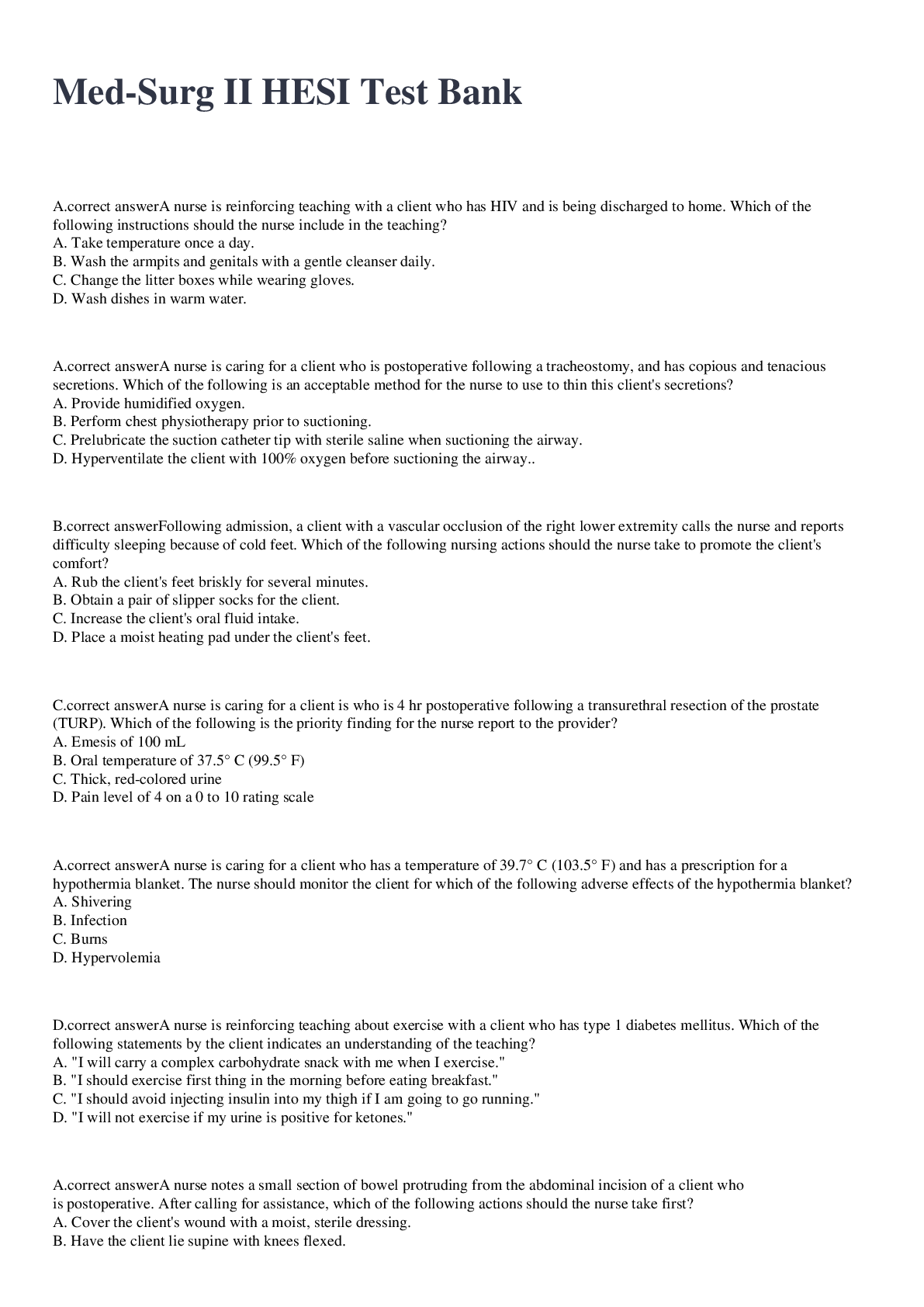

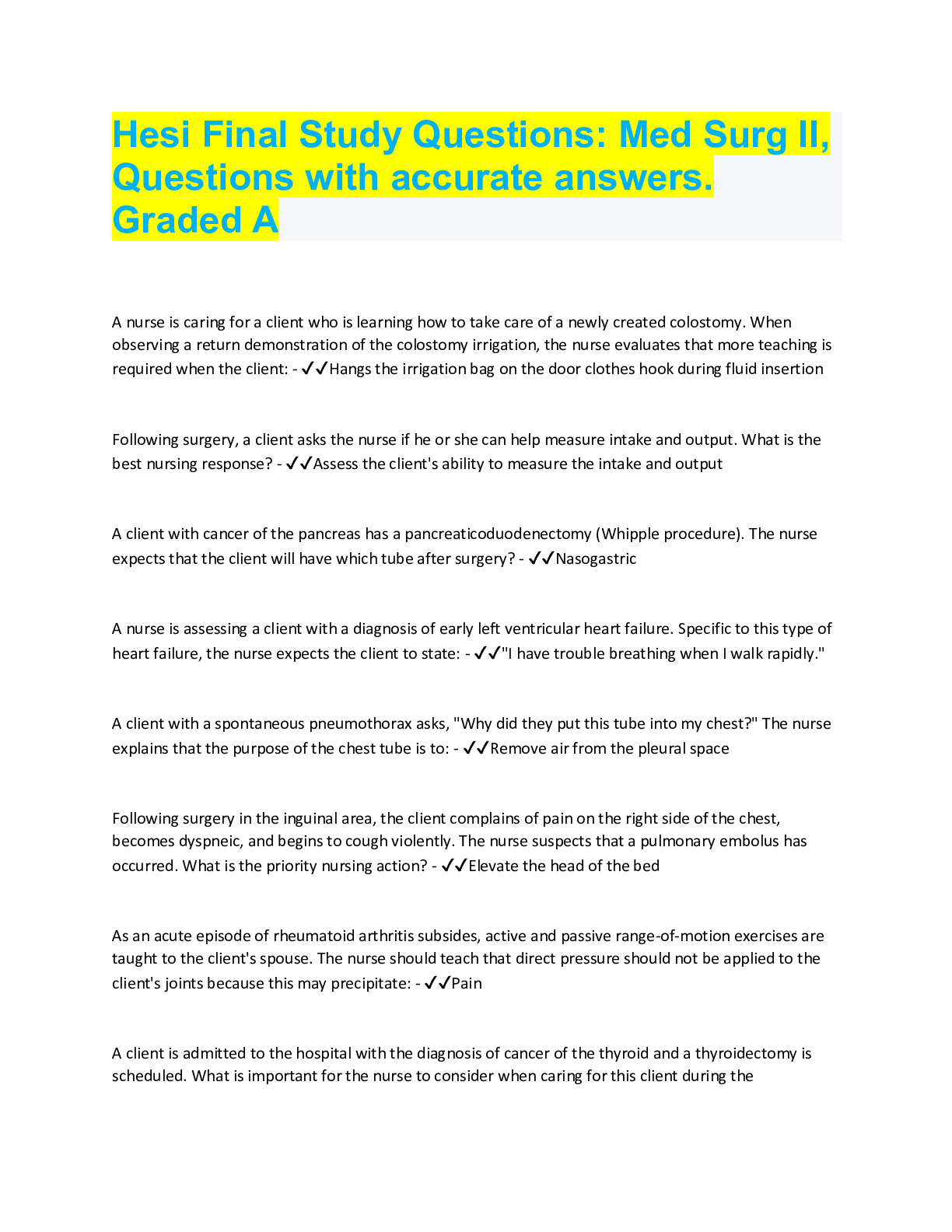


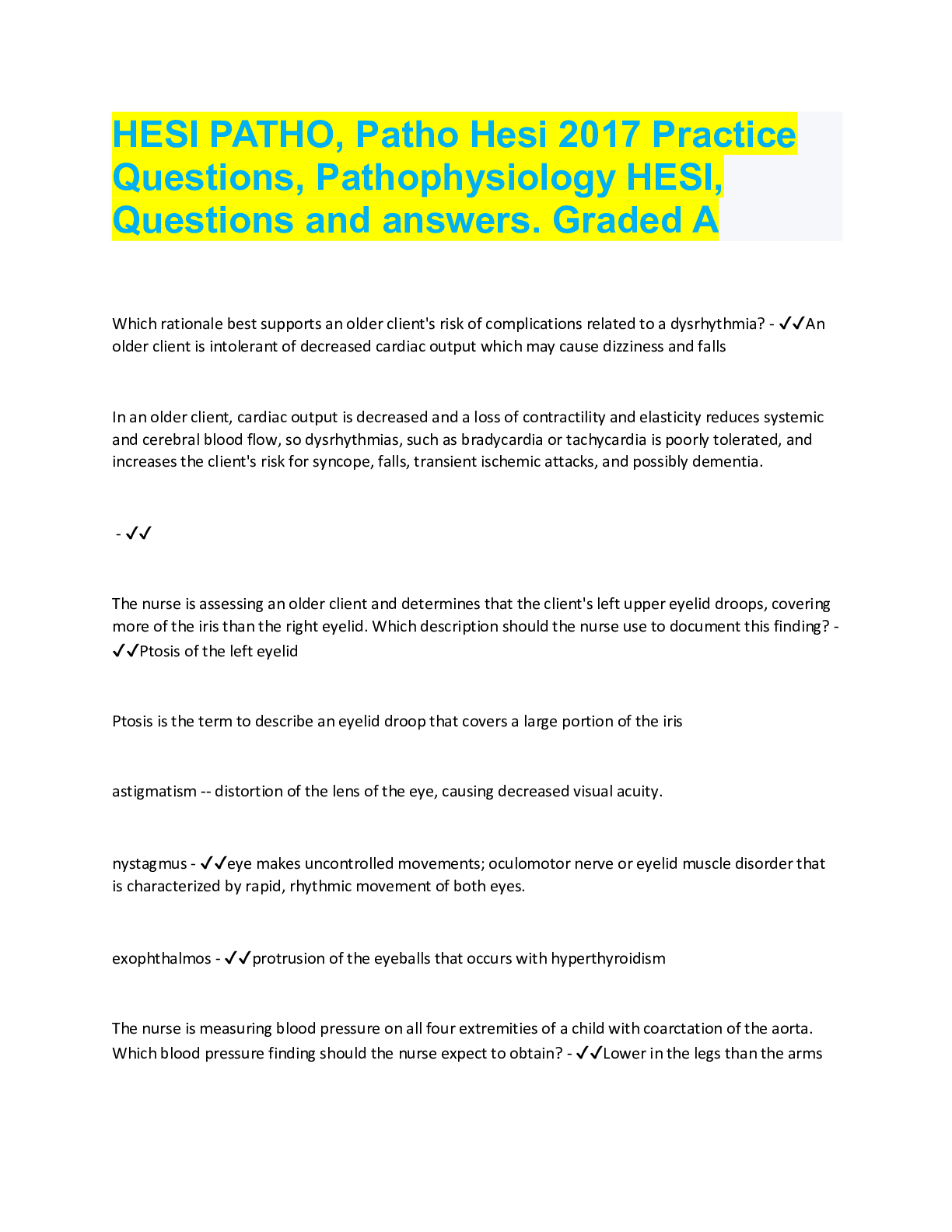
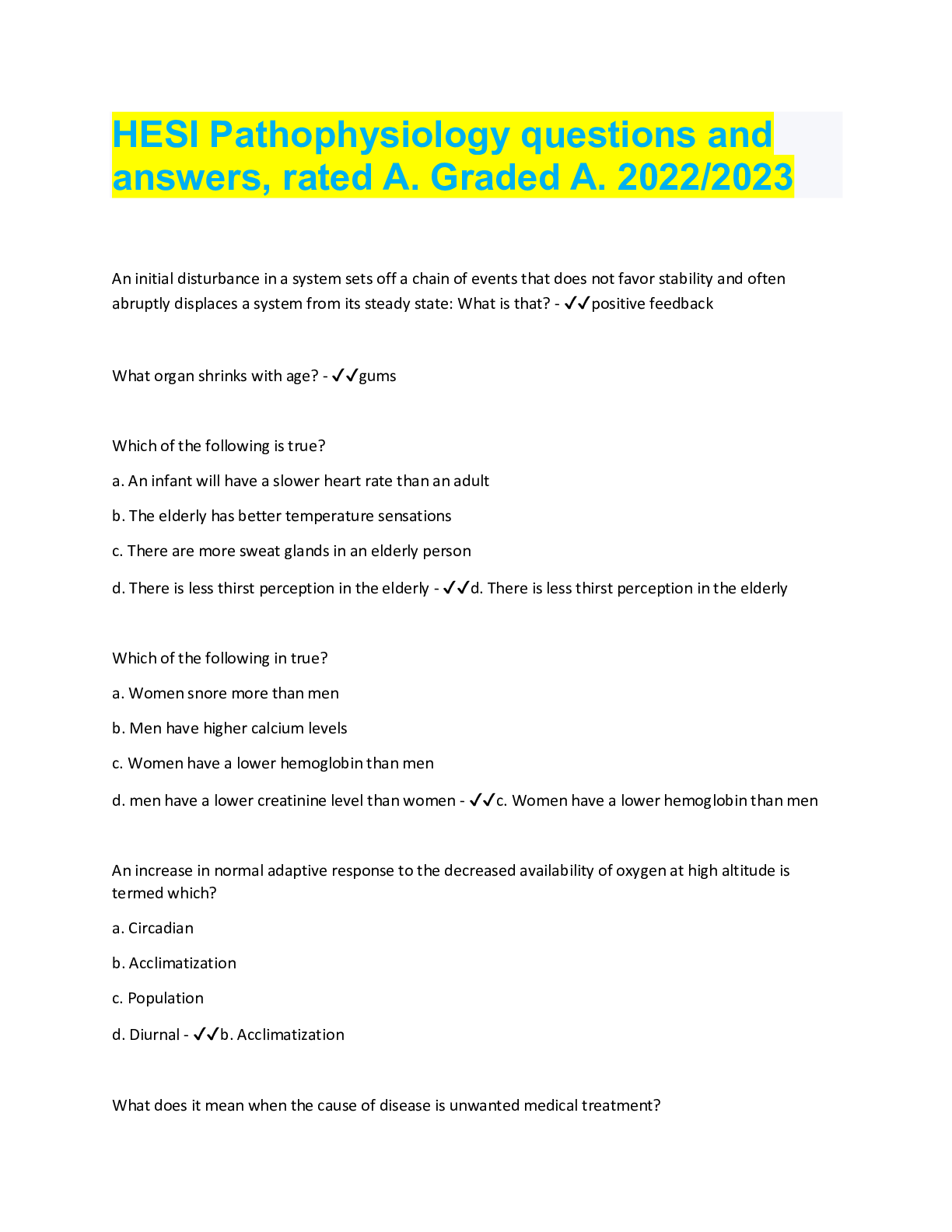
_merged.png)
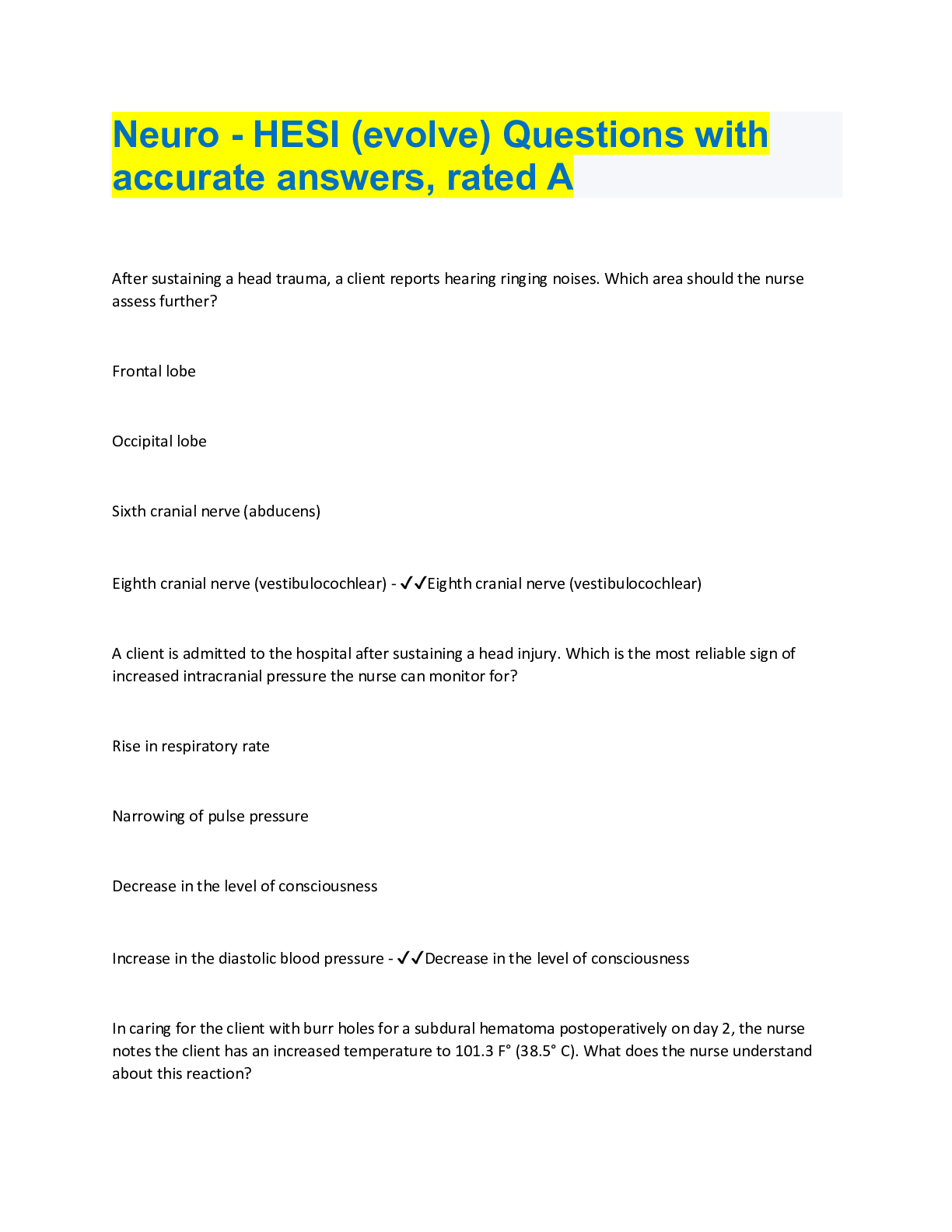
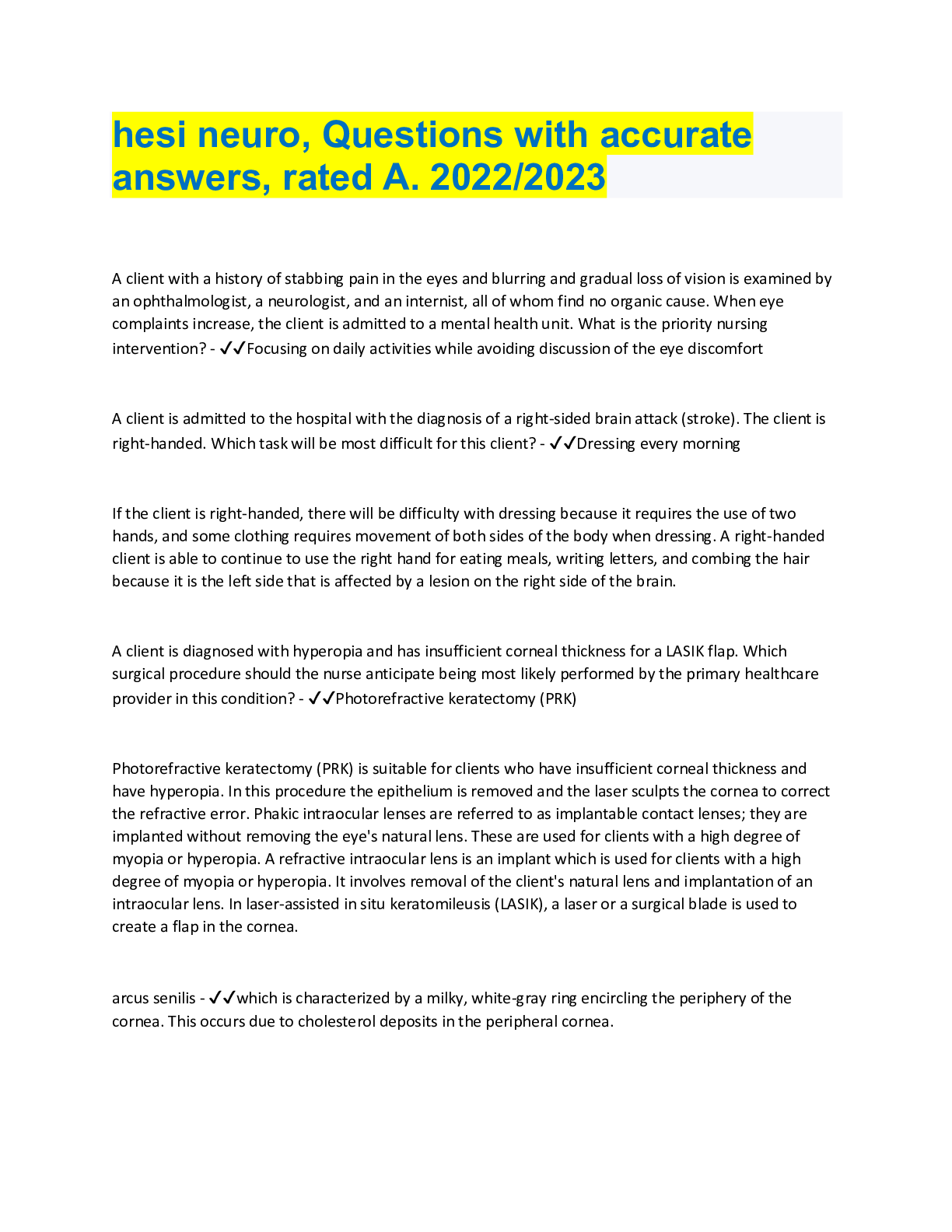

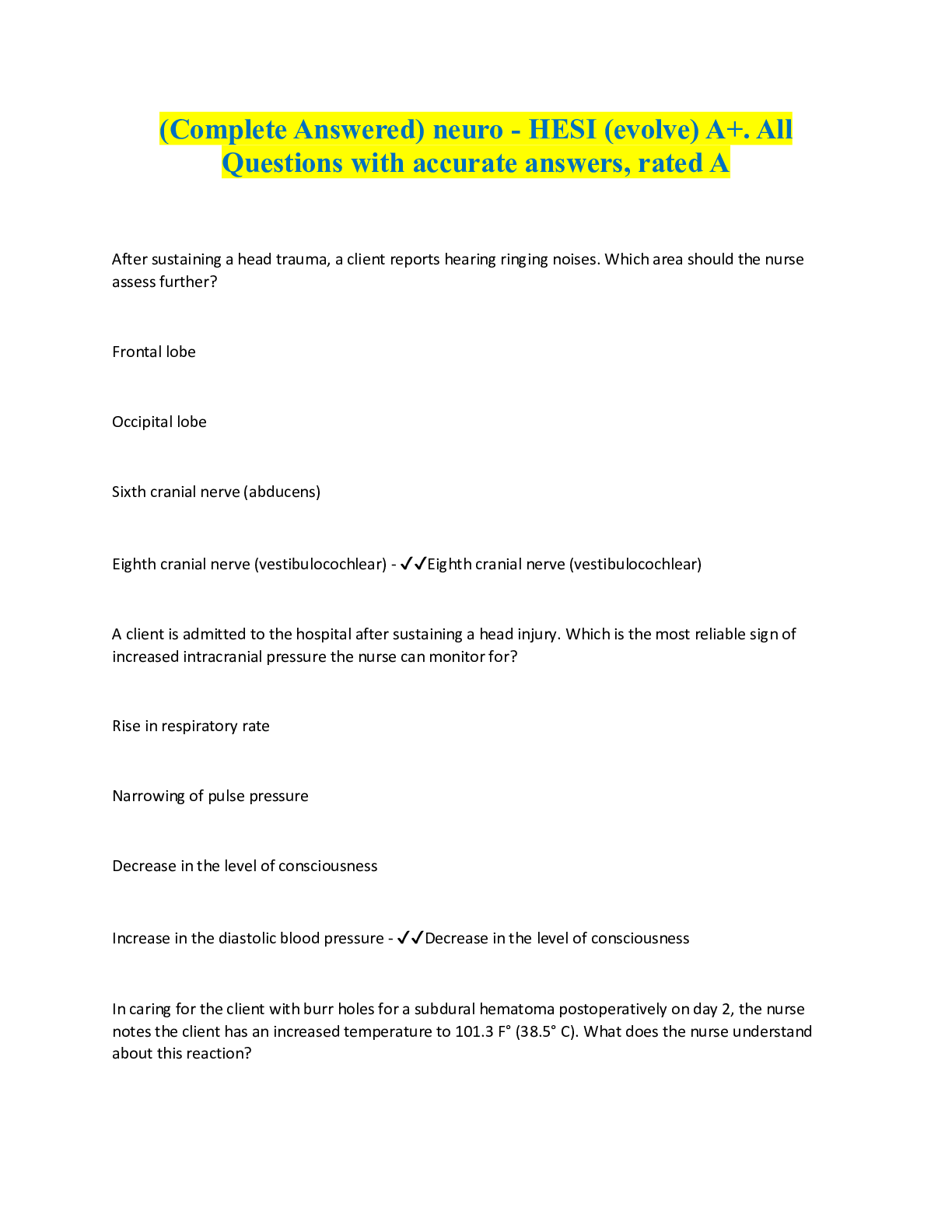
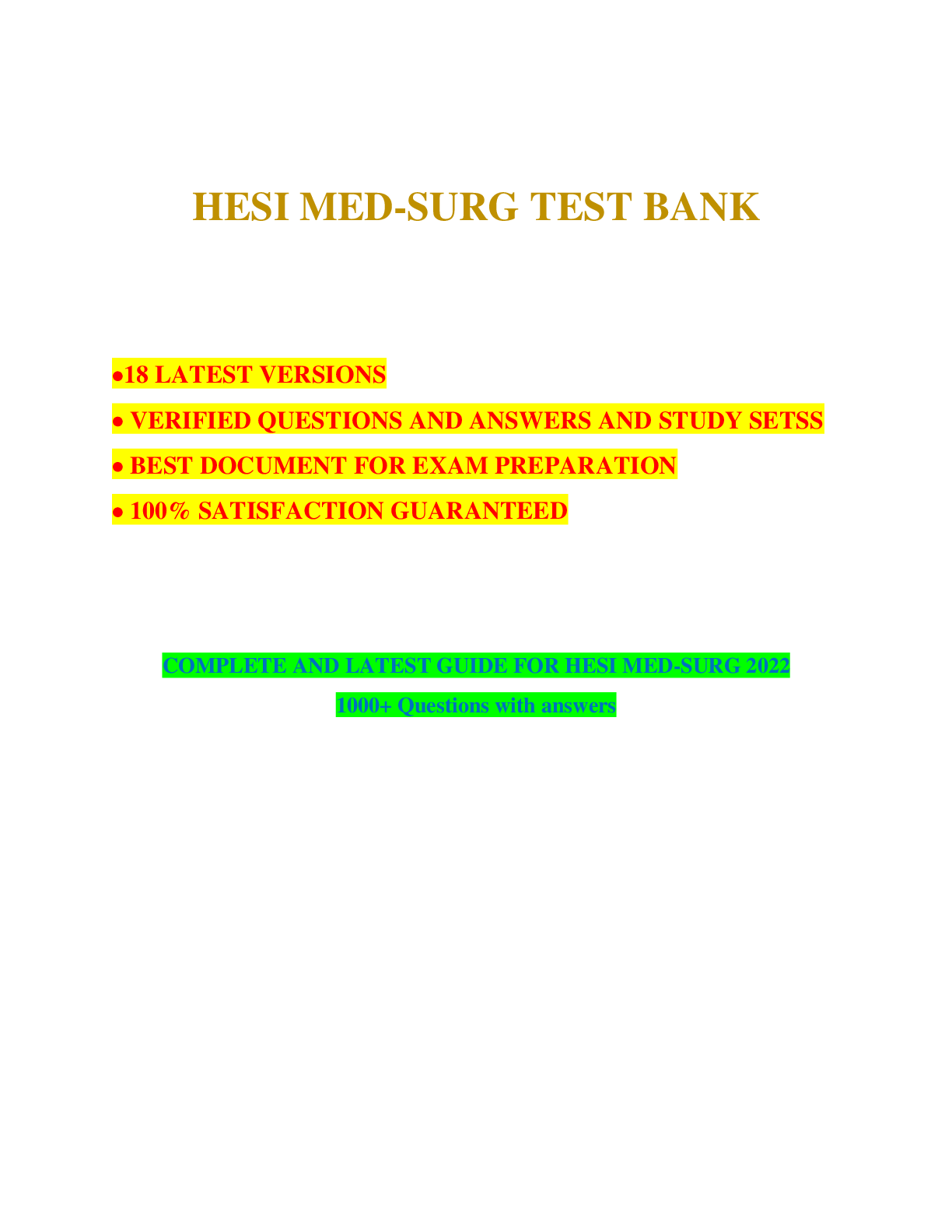


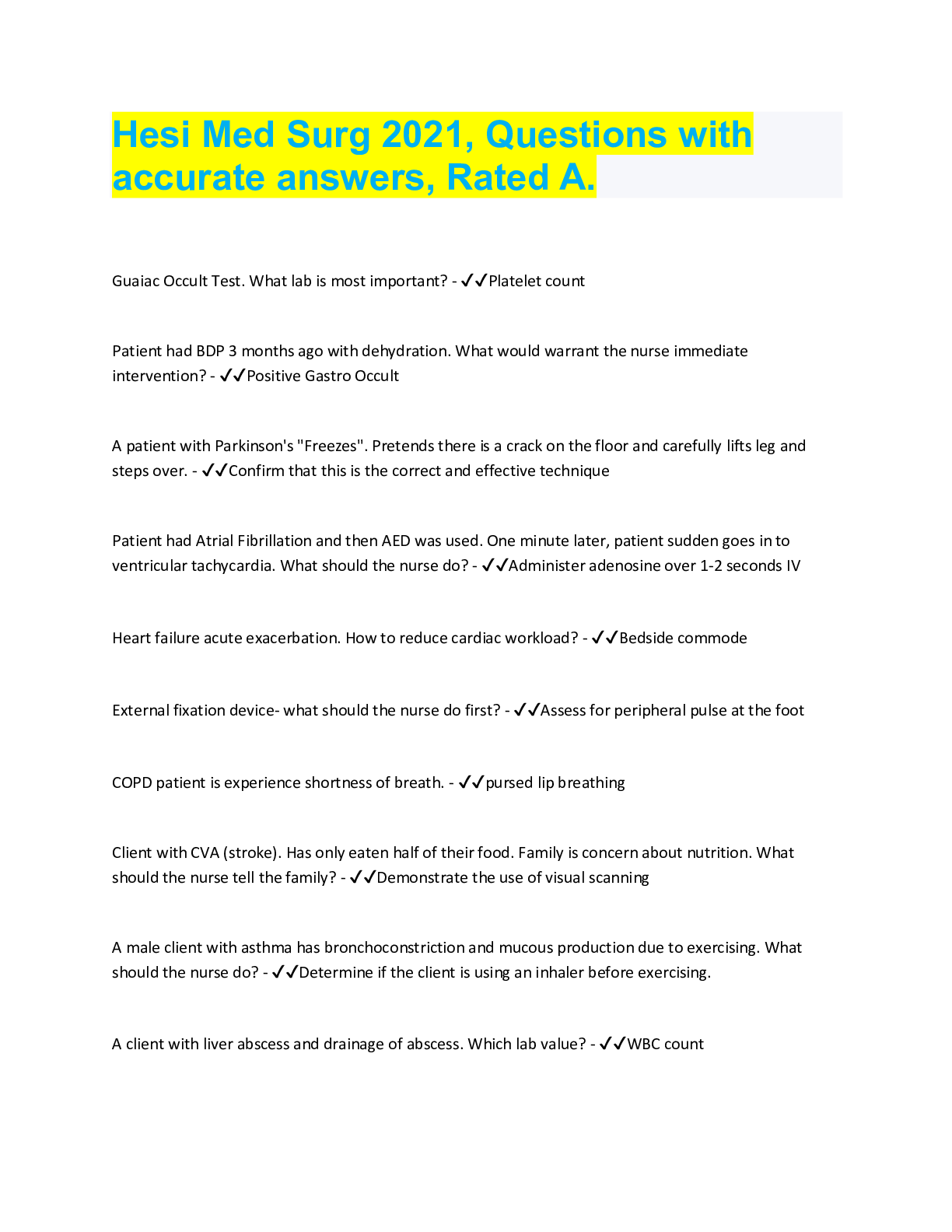



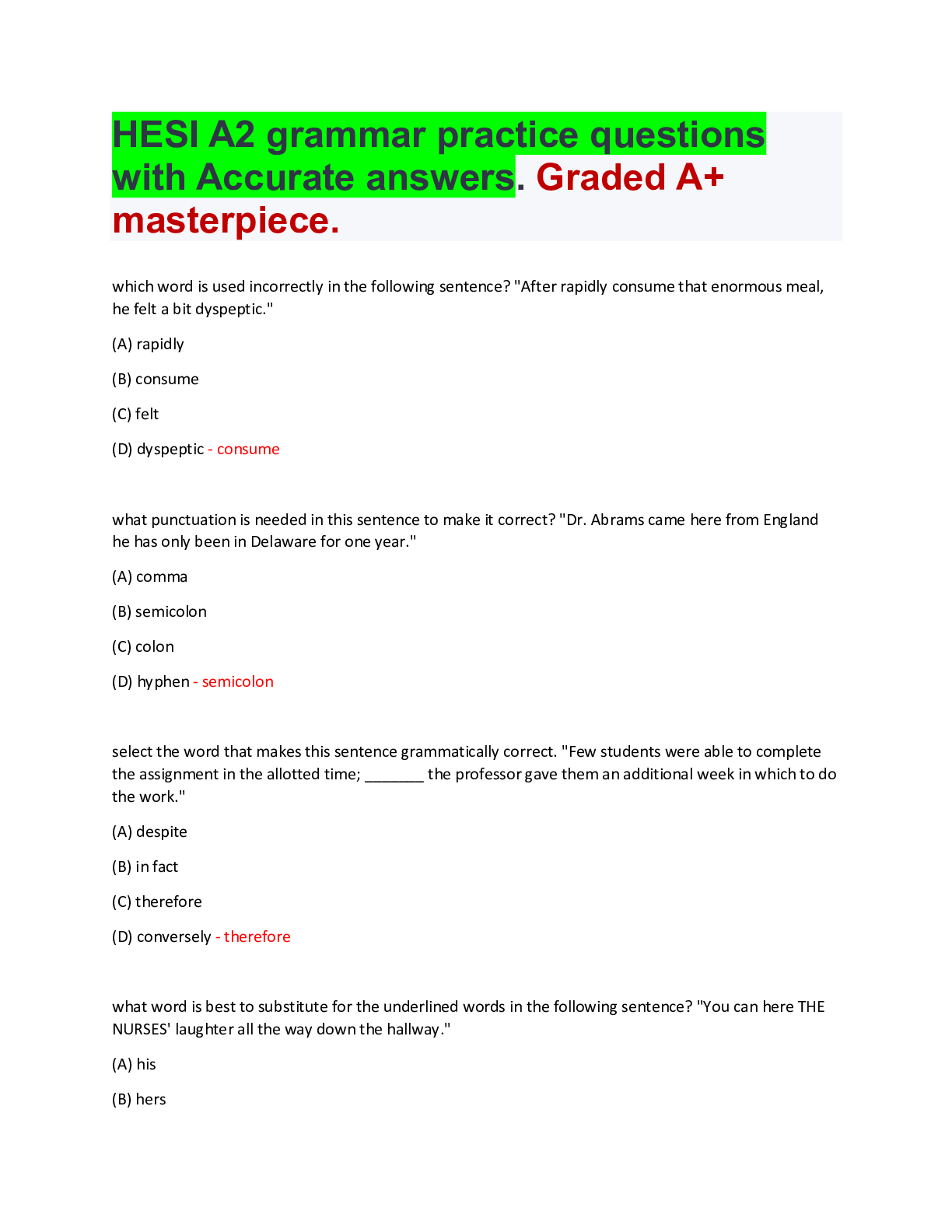



.png)
.png)
.png)
